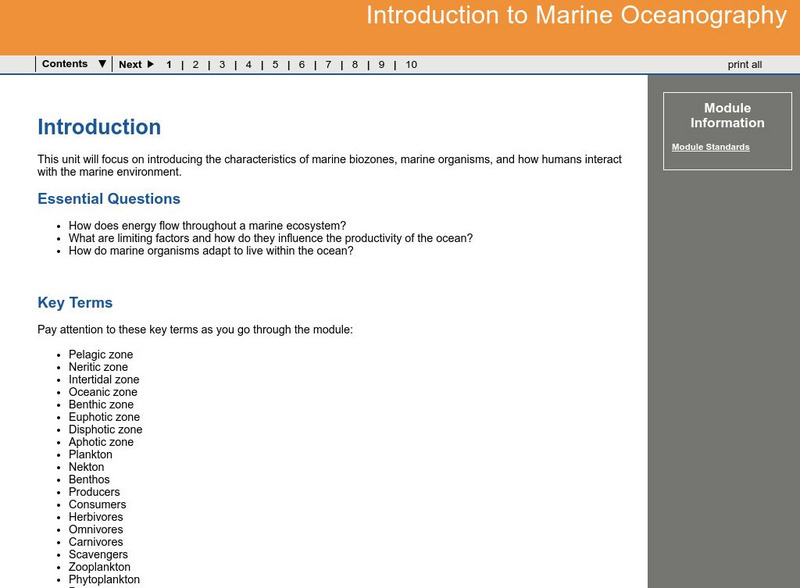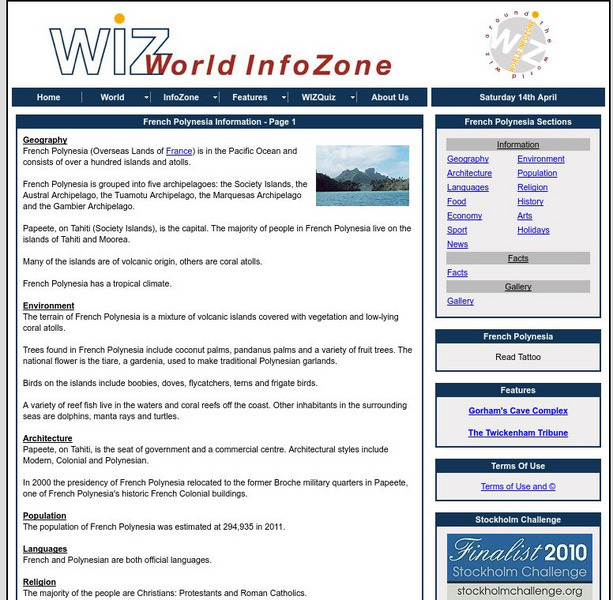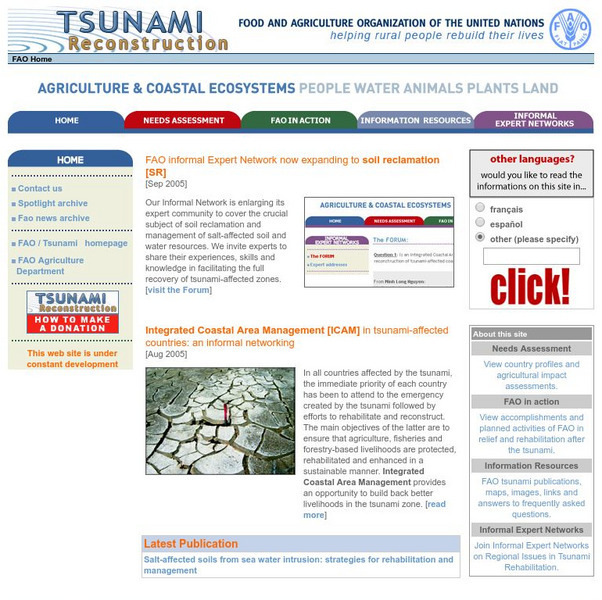American Museum of Natural History
American Museum of Natural History: O Logy: What's the Big Idea? Marine Biology
An introduction to key concepts about the ocean, its ecosystems, and zones. With interactive flash cards that open in new windows to help you learn more.
World InfoZone
World Info Zone: Solomon Islands
Great resource for finding background and current information about the Solomon Islands in the Pacific Ocean. Content includes geography, environment, architecture, religion, food, history, economy, arts, sports, and news. Be sure to...
EL Education
El Education: In the Zone: Where the Land Meets the Water
This field guide to the marine organisms of the intertidal zone of Casco Bay was created by 7th grade students in Portland, Maine, as part of a Learning Expedition called, "In the Zone." Students were engaged in scientific research at...
Georgia Department of Education
Ga Virtual Learning: Introduction to Marine Oceanography
Students learn about marine biozones, marine organisms, and how humans interact with the marine environment.
NOAA
Noaa: Ocean Facts on Coastal Tourism
The National Oceanic & Atmospheric Administration surveys coastal travel and tourism, which is the largest industry, employer, and foreign-revenue earner in the United States.
The Franklin Institute
Marshall Elementary School: Ocean Games & Puzzles
Complete interactive word searches to find animals of the intertidal zone. Learn ocean facts by completing a crossword puzzle. Match up pieces of a puzzle to display the water cycle. And after learning all that information, test yourself...
Science Buddies
Science Buddies: Timing the Tides
Have you ever been to a tide pool during low tide? Some intertidal animals in the low tide zone are left in a tiny pool of water when the tides go out. Other intertidal animals that live in high tide zones may be left to dry out during...
Open Curriculum
Open Curriculum: Aquatic Biomes
This study information describes how aquatic biomes are divided into zones, and lists types of aquatic organisms.
Alabama Learning Exchange
Alex: Diverse Life Forms of the Ocean
This lesson allows young scholars to view and draw conclusions on the importance of life in the ocean. It uses student created movies to explore what is going on, as well as identifying the zones and diverse life associated with the...
World InfoZone
World Info Zone: French Polynesia
Great resource that is full of useful information about French Polynesia which is in the Pacific Ocean. Content includes geography, environment, architecture, religion, food, history, economy, arts, sports, and news. Be sure to look at...
Other
Moorland School: Earth Science Zone: The Structure of the Earth
Take a look at the Earth from the inside out. This site shows the different layers of the earth with an explanation of the rocks and materials in each layer. Includes a quiz on the structure of Earth.
Other
Sydney Aquarium: Explore Our Zones
Take a tour of the Sydney Aquarium and learn about the diverse aquatic environments.
NOAA
Noaa: Ocean Facts on Coastal Development
Resource provides facts on Coastal Development as well as how it affects you.
TED Talks
Ted: Ted Ed: The Otherworldly Creatures in the Ocean's Deepest Depths
Although the deep ocean zone seems like an inhospitable and remote corner of the planet, it is actually one of the greatest habitats on Earth. Lidia Lins explores how so many species thrive in this mysterious underwater world. [5:02]
ClassFlow
Class Flow: Ocean Life
[Free Registration/Login Required] This flipchart is about the different ocean zones: sunlight zone, twilight zone, and midnight zone. It contains video about ocean life in the different zones.
National Geographic
National Geographic: Adapting Under Pressure
Students learn about James Cameron's Challenger Deep dive and about the marine animals that live in different layers of the ocean. They then study the characteristics of the hadalpelagic zone at the bottom of the ocean, and imagine and...
The Wild Classroom
The Wild Classroom: Biomes of the World: The Deep Sea Biome
Learn all about the abyssal ocean ecosystem. Find out about plants, animals, adaptations, and conservation efforts.
Other
Digital Library for Earth System Education: Teaching Box: Seasonal Upwelling
A suite of lessons focusing on the process of upwelling. Inquiry-based exploration of seasonal upwelling includes marine food webs, food production in the ocean, wind-driven ocean currents, and seasonal changes in biotic and abiotic...
Indiana University
Indiana University: Evolution of Continents and Oceans
A course lecture on how the Earth's geological features have evolved through the movements of tectonic plates. Explains the different types of plate boundaries and how they manifest in geological formations. Also describes the structure...
Untamed Science
Untamed Science: Biology: World Biomes: Pelagic Biome
Learn about the different zones of the open ocean, the pelagic biome, and what organisms call each zone home.
Encyclopedia Britannica
Encyclopedia Britannica: Geology: Deep Sea Trench
Detailed information about oceanic trenches, their structure, and how they are formed. Discusses the twenty trenches that exist around the world. Includes several labeled illustrations.
National Geographic
National Geographic: Visualizing Watershed Health
Using data visualizations that show dissolved oxygen levels, students analyze the health of the Chesapeake Bay watershed. They will also learn about dead zones, which are aquatic areas where there is insufficient oxygen to support life....
Food and Agricultural Organization of the United Nations
Food and Agriculture Org.: Tsunami Reconstruction
The waves have retreated, but what lies in the destruction zone and how do people put their lives back together? The Food and Agriculture arm of the UN lists updates on the reconstruction going after the 2004 Indian Ocean tsunami.
Science Education Resource Center at Carleton College
Serc: Lab 7: Nitrates and Phosphates and Algae, Oh My!
A lab experiment, in a series of experiments, that investigates fisheries. In this lab, students test the effects of fertilizers and other pollutants on a model ecosystem. Students also examine 2 years of ocean color (chlorophyll...





















